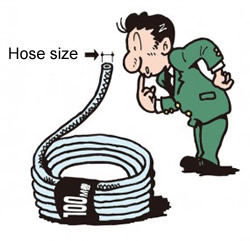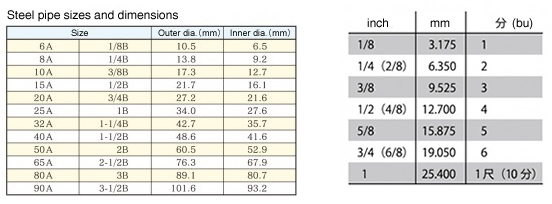Hose and Coupling Knowledge Base
If You Register to Become a Web Member, We Will Send You the Latest Information on Hoses and Coupling.
How to Read Catalog Specifications, Part 4 – Are Hose Sizes Random?

This topic is about hose sizes.
Toyox’s TOYORON Hose line ranges from 4 millimeters in diameter to 75 millimeters, in 16 sizes. The sizes do not increase uniformly, however, and it is difficult to figure out how the sizes were determined. Are hose sizes determined by law?
Hose lengths come in a variety of units, including meters, feet, inches and native Japanese lengths. Most Japanese catalogs list lengths in meters.
Today, hoses are usually connected using a specialized hose coupling that the hose fits into, but previously, hoses were directly connected to pipes. Vinyl chloride and other pipes are sized in inches. Here are some basic approximate conversions:
1 inch = 25 mm
3/4 inch = 19 mm
5/8 inch = 15 mm
1/2 inch = 12.7 mm
Because the outer diameter is used as the size for pipes, hoses, which are inserted into pipes, are sized by their inner diameter. Most Japanese catalogs indicate the inner diameter of hoses in millimeters, and therefore the sizes may seem haphazard.
In Japan, hoses are also measured in bu. The bu is part of the traditional Japanese measuring system, and at one-hundredth of a shaku is about 3 millimeters. Coincidentally, this is very close to an eighth of an inch. One inch is 25.5 millimeters, and one-eighth of an inch is 3.175 millimiters. It should be noted that the bu used for steel pipe measurement is slightly different.

Archive
How to Cut Steel-Wire-Reinforced PVC Hose
Does Electricity Conservation Increase Condensation?
Why Do Hoses Leak & Disconnect?
Can PVC & Other Plastic Hoses Be Used for Fuel Gas & Kerosene?
How to Read Catalog Specifications, Part 4 – Are Hose Sizes Random?
How to Read Catalog Specifications, Part 3 – Minimum Bend Radius
Beware of Static Electricity on Hoses
How to Read Catalog Specifications, Part 2 – Negative Pressure+B10
About REACH, RoHS, Endocrine Disruptor & the Food Sanitation Act
How to Read Catalog Specifications, Part 1 – Use Pressure
How to Avoid Damage Caused by Ultraviolet Rays
The Dangers of Hose Condensation
Why Transparent Hoses Become Cloudy
Leaks & Disconnections Due to Mismatched Couplings & Hoses
Causes & Solutions for Leaks & Disconnections
The Benefits of the Right Hose for the Situation (2)









